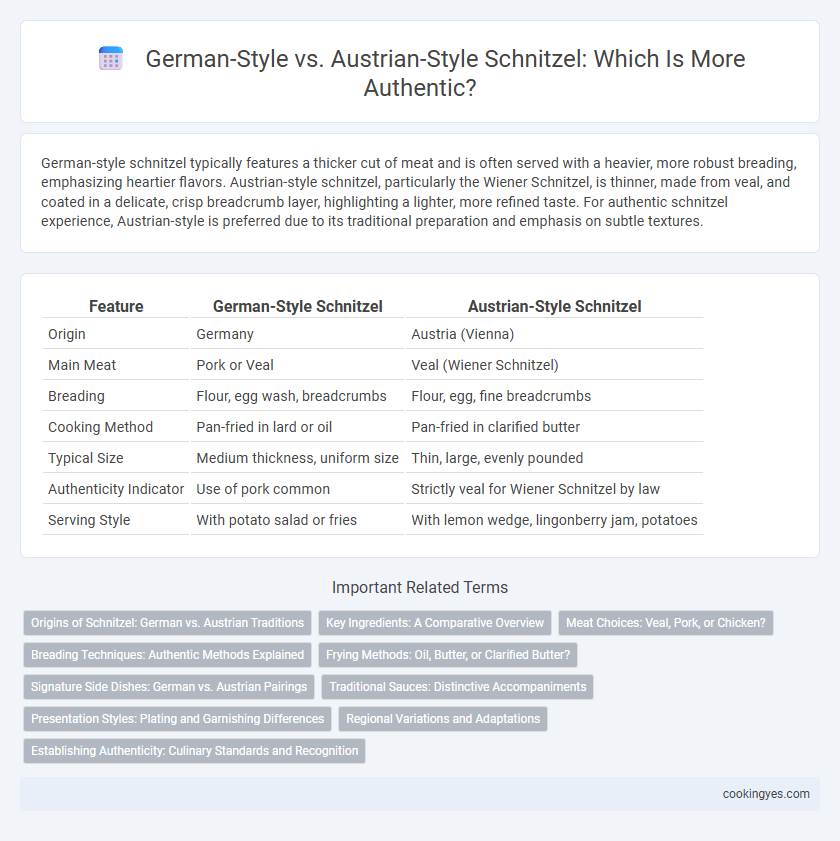German-style schnitzel typically features a thicker cut of meat and is often served with a heavier, more robust breading, emphasizing heartier flavors. Austrian-style schnitzel, particularly the Wiener Schnitzel, is thinner, made from veal, and coated in a delicate, crisp breadcrumb layer, highlighting a lighter, more refined taste. For authentic schnitzel experience, Austrian-style is preferred due to its traditional preparation and emphasis on subtle textures.
Table of Comparison
| Feature | German-Style Schnitzel | Austrian-Style Schnitzel |
|---|---|---|
| Origin | Germany | Austria (Vienna) |
| Main Meat | Pork or Veal | Veal (Wiener Schnitzel) |
| Breading | Flour, egg wash, breadcrumbs | Flour, egg, fine breadcrumbs |
| Cooking Method | Pan-fried in lard or oil | Pan-fried in clarified butter |
| Typical Size | Medium thickness, uniform size | Thin, large, evenly pounded |
| Authenticity Indicator | Use of pork common | Strictly veal for Wiener Schnitzel by law |
| Serving Style | With potato salad or fries | With lemon wedge, lingonberry jam, potatoes |
Origins of Schnitzel: German vs. Austrian Traditions
The origins of schnitzel reflect distinct German and Austrian culinary traditions, with the Wiener Schnitzel from Austria being the most iconic, traditionally made from veal and breaded to crispy perfection. German schnitzel variants often use pork instead of veal and may feature regional spice blends or sauces, emphasizing heartier flavors. Authenticity in schnitzel hinges on these differences in meat choice, preparation, and cultural heritage between Austria's Wiener Schnitzel and Germany's diverse schnitzel styles.
Key Ingredients: A Comparative Overview
German-style schnitzel traditionally uses pork or veal coated in flour, egg wash, and breadcrumbs, often fried in lard, resulting in a crispy, golden crust. Austrian-style Wiener Schnitzel exclusively features veal, coated with fine breadcrumbs without flour, then fried in clarified butter to maintain a delicate, tender texture. Key ingredient differences reflect regional preferences, with Austrian schnitzel emphasizing veal quality and lighter frying fats, while German variants favor heartier pork and robust frying mediums.
Meat Choices: Veal, Pork, or Chicken?
German-style schnitzel typically features pork, offering a slightly more robust flavor and a thicker cut, while Austrian-style Wiener Schnitzel mandates veal for its tender texture and subtle taste, strictly adhering to traditional authenticity rules. Chicken schnitzel, although popular in both regions for a lighter and leaner option, is often considered a modern adaptation rather than an authentic classic. The choice of meat directly impacts the dish's culinary heritage and regional identity, with veal symbolizing Austrian delicacy and pork embodying German heartiness.
Breading Techniques: Authentic Methods Explained
German-style schnitzel typically uses a three-step breading process involving flour, beaten eggs, and coarse breadcrumbs to achieve a crunchy texture with a thicker coating. Austrian-style Wiener Schnitzel traditionally opts for fine, fresh breadcrumbs and a delicate, thinly pounded veal cutlet, emphasizing a lighter, crisp crust. Both methods rely on precise breading techniques to preserve authenticity while delivering distinct regional flavor and texture profiles.
Frying Methods: Oil, Butter, or Clarified Butter?
Authentic German-style schnitzel is traditionally fried in clarified butter, which provides a high smoke point and a rich, nutty flavor essential for crispiness without burning. Austrian-style schnitzel often uses a blend of oil and butter, balancing the butter's flavor with oil's higher heat tolerance for a golden, evenly fried crust. Choosing the right frying fat influences the schnitzel's texture and authenticity, with clarified butter favored for a classic German crispness and the oil-butter mix typical in Austrian kitchens.
Signature Side Dishes: German vs. Austrian Pairings
German-style schnitzel is traditionally paired with potato salad, sauerkraut, or red cabbage, emphasizing hearty, tangy flavors that complement the crispy breaded pork or veal. Austrian-style schnitzel is famously served with a slice of lemon, lingonberry jam, and a light parsley potato salad, highlighting a balance of citrus brightness and subtle sweetness alongside tender veal. These signature side dishes underscore the regional authenticity, with Germany favoring robust, earthy accompaniments and Austria highlighting lighter, nuanced contrasts for the schnitzel experience.
Traditional Sauces: Distinctive Accompaniments
Traditional German-style schnitzel is often paired with sauces like Jagersosse, a rich mushroom gravy, and Zigeunersosse, a tangy bell pepper sauce, highlighting robust and earthy flavors. Austrian-style schnitzel, particularly Wiener Schnitzel, is authentically served with simple yet distinctive accompaniments such as lemon wedges and lingonberry jam, emphasizing a clean taste that complements the crispy veal. These sauce choices define the authenticity of schnitzel preparations by showcasing regional preferences and culinary heritage.
Presentation Styles: Plating and Garnishing Differences
German-style schnitzel typically features a thicker breading and is often presented with a lemon wedge, accompanied by potato salad or spaetzle, emphasizing rustic and hearty plating. Austrian-style schnitzel, particularly the Wiener Schnitzel, is renowned for its thin, uniformly pounded veal cutlet with a delicate golden crust, served elegantly with parsley garnish and a slice of lemon, often alongside lingonberry jam or cucumber salad. The contrasting garnishing and plating highlight German schnitzel's robust comfort-food appeal versus the refined, minimalist elegance characteristic of Austrian schnitzel presentation.
Regional Variations and Adaptations
German-style schnitzel often uses pork and incorporates a thicker breading with seasoned flour, reflecting regional preferences for heartier textures. Austrian-style schnitzel, especially the Wiener Schnitzel, is traditionally made with veal, featuring a thinner, delicate breadcrumb coating that emphasizes lightness and crispness. Both styles showcase adaptations to local tastes and ingredients, highlighting regional culinary identities within schnitzel authenticity.
Establishing Authenticity: Culinary Standards and Recognition
German-style schnitzel, often linked to cities like Munich, traditionally uses pork and emphasizes a thicker, coarser breadcrumb coating, reflecting regional preferences and culinary standards codified by local food associations. Austrian-style schnitzel, particularly the Wiener Schnitzel, holds protected designation of origin status within the EU, mandating veal as the authentic meat and a delicate, fine breadcrumb crust, ensuring strict adherence to historical recipes and preparation methods. Both styles have gained international recognition, but authenticity is established through compliance with these specific ingredient criteria and preparation techniques endorsed by established culinary institutions.
German-style vs Austrian-style for schnitzel authenticity Infographic

 cookingyes.com
cookingyes.com